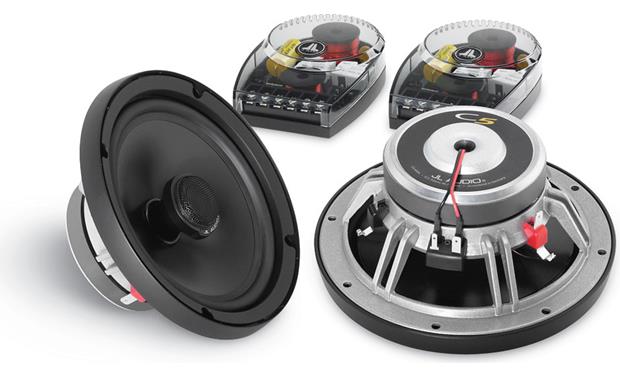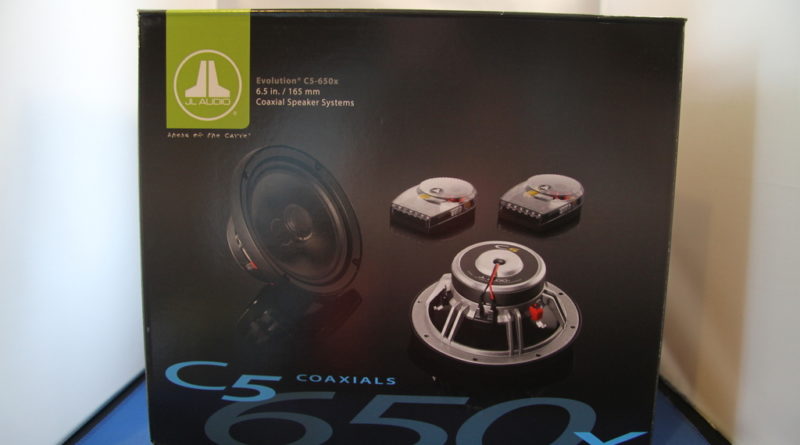JL Audio C5-650X Coaxial Speakers
Manufacturer: JL Audio
Distributor: Celsus
Website: link
Typical Selling price: £429.99
In A Nutshell
As utterly JL Audio as it gets, but oddly, made in Germany to be so. These are coaxials – also available as components. Unashamedly high end, they present astonishing layered nuance and detail with huge power and bass frequency capability. Great for close mic vocal material, awe inspiring with any truly challenging and well produced music. fabulous quality that can embarrass home hifi speakers up to around a thousand pounds’ worth, I feel. I absolutely recommend these but you must use them with a high end source and top quality amplifier to hear the true dynamics and breadth of their skills. State of the Art.
Overall 9.6
Sound Quality 10
Build Quality 10
Power 10
Efficiency 9
Value For Money 9
These are truly state of the art.
Editor Review : JL Audio C5-650X Coaxial Speakers
If you have read a few of these, you will know that this is the seventh of seven loudspeaker reviews, all of the same size product. (Given that 6 1/2 and 6 3/4 inch speakers will fit in the same holes) You will also know that I suffer a little angst at the outset each time. There is always that nagging fear that I will not be able to tell the difference.
Now this set of JL Audio C5-650X loudspeakers, which have sumptuous off-board passive crossovers, are only configurable as coaxial. The C3 set last reviewed could be mounted as coaxes or components. I admitted to personal prejudice, fitted the gorgeous phase plugs in their middles to replace the tweeter poles and mounted their tweeters as components. By way of contrast, this C5 set is fully £100 more money than the C3 and yet when I fired them up I got a little fright. I was scared that I could not tell what was going on.They were good but not awesome
This next bit may sound a little odd to you and as ever, you will have to endure a little anecdotal history. The thing is, I have pointy ears like a pixie. I used to keep their tips hidden, asking the barber to cut my hair so it covered them a little because for my entire youth, I would get called ‘˜Spock’ or worse for my elvish pinnae. Every mammal that really needs to hear the background, has pointy ears. Predators zooming in on mice by sound have very pointy ears to give them excellent locational cues for pouncing. Also, I have problems wearing glasses, with the frames sitting diagonally across my face. This is because I have one ear nearly a centimetre higher than the other. Yup, I am one misshapen git. Now if you can be bothered, go do some research on the ears of a barn owl. Their auditory openings are offset vertically upon their skulls instead of being pointy. This gives me and the owls astonishing high-frequency locational resolution of hearing. Once, (sadly long enough ago for me to worry if it is still as acute) I was production manager for Acoustic Energy loudspeakers and heard a 0.18 ohms difference on a passive crossover I was listening to. (We tested each bit by ear before assembly to save effort, frankly.) The boss had to strain to make it out but could, after I said that this one passive assembly was a bit dull. He measured said passive crossover subassembly and found that tiny difference. Small changes in the passive crossover to do with the resistors in particular can be really audible. I think it is like a perfect calcite crystal with a sharp tip, just dulled a tiny bit.
Although obviously somewhat obsessive, I am a lazy (fat) man and hate doing anything twice. I had assembled the beautiful passive crossovers and inserted them within the enclosures with the passives set to ‘˜Reference’. However, I stood there upon very first audition, worried. Because while excellent, I needed to know why these were £100 more expensive. It needed to be more than the fact that this set alone were made in Germany and I couldn’t quite hear the expected perfection of rise time and detail.
I have reviewed very high end German hifi home loudspeakers. I have been on a press trip to Berlin and heard the finest speakers they can make. The Teutonic ear is somewhat different to the North American. Japanese companies have been known to manufacture loudspeakers with different voicing for different territories. Whether it be home audio or car hifi, most commentators in my world agree that North American loudspeakers can be described as ‘˜ballsy’ with no fear of appearing high potency as well as high clarity. Whereas, the German ear tends towards fabulous detail but like their public persona always avoids being brash. British hifi is respected worldwide for its general if polite musical voicing.
I had found the C3-650 set to be a little strident, even agreeing that leaving their midband presence and tweeter levels on the ‘˜reference’ setting jumpers in their passives might be a good idea. These crossovers are not active, or powered, devices, so cannot ADD anything but can do filtering or act like a traffic cop for sound. There are three or four choices of paired pins on each side of the circuit boards on C3 and C5s’ passive crossovers. You lift, disconnect, then replace a little tab connector to choose which of these pins are used. On the supposedly ‘˜plus’ set of pins you have no resistors in the circuit. ‘˜reference’ adds one, with the other, then presumably both resistors able to be put in circuit for a little attenuation. That’s the HF, anyway. for the midband presence, I actually asked all the way to Miramar and Eric Cole, technical support specialist, to be told that, ‘There is a multi tap inductor used to low pass the midrange. It is multi tap so that you can change the midrange presence with the jumpers on the passive crossover. At the Ref position the low pass is matched up the same as the high pass on the tweeter. In Low it places a gap between the low pass of the midrange compared to the high pass of the tweeter. In High the low pass overlaps the high pass of the tweeter for enhanced upper midrange’ So this is not the same as the highs, this is a cool inductor core with more than one place to connect it. I set it to ‘+’.
Now, I loathe resistor-based attenuation with a passion. However, I had taken my own advice, setting these C5-650X up with their passives set to ‘˜Reference’ and found myself listening to a high-quality output but wondering where the extra hundred quid was being spent. Thus, lazy or not, I dis-installed the loudspeakers, put the jumpers to their respective ‘˜positive’ positions and started again.
And at bloody last I got it! Wow! First, here is the video.
I have been lucky enough to have listened to the finest from the likes of B&W, Wilson, KEF and Meridian, as well as but the best from other territories. One of the biggest tenets of all hifi and indeed most things is the law of diminishing returns. Above a certain level of excellence, you have to start spending cruelly more money to gain tangible yet ever smaller benefits. And these are the ones above the awesome C3. So what do you get that is better for your extra £100?
Let us deal with the obvious parts first. The JL Audio C5-650X loudspeakers on test here are very high quality and really very wide ranging. The bass end was more authoritative than I have heard from manufacturers spending a lot more money with similar transducers on home audio, with ‘˜perfect’ enclosures. They sound audibly better than the C3. The output was lush, it had grip and it stopped when the bass did. The sheer musical richness of this lower frequency zone was like a Texan fruitcake. Coherent, delicious and sumptuously enjoyable. Likewise, this speaker system truly enjoyed the Morel four channel amplifier I have been using for reference wattage. The power handling was prodigious. Just like the C3 yet even more ethereally delicious, the music did not sound like it was coming from the boxes. The C5s’ sound stage had both height and depth, even in my funny old test rig. They are true hifi.
And then finally, I think I really understood. Yes, the folks who sell all these loudspeakers from under fifty quid to these C5-650X at nearly nine times the price, care like hell about value for money. At each price point what you get is beyond keen, with my flinging full marks for VFM about. These are proper money and are affected by that diminishing returns for excellence principle as well as the extra costs of specialist European collaboration with Kurt Müller, which cost one VFM point. But I got it
The C5-650X loudspeakers are for the utter enthusiast of the ultimate sound quality. This is a product for the people who have got it really bad. A good few could be car audio competition entrants, except that their bold adherence to the coaxial format in a world of three-way components may hold them back. No, perhaps the real buyer of these C5-650X speakers is the blokey hifi fanatic who listens to closely recorded female vocals.
I have written about this bloke before, because yes, I think this will be all men at this level. It took me two decades to finally understand but it is about having that girl in the car with you. And not just a good stereo image but so bloody clear, so utterly real and believable, that were you not driving you could close your eyes lean forward and kiss her full on the lips. You can talk about emotion, musical nuance and utter detail but I think the true buyer of this product wants to kiss Rebecca Pidgeon. (In my case, it is Adele.)
Here is a bonus and a first in all the years the track I talk about..listen for mouth sounds and you can see the feeling on her face, just by LISTENING. I recommend you go buy this in high resolutionI just got goosebumps, even in YouTube resolution music. but I have heard this on awesome systems.
So in conclusion, this £430 pounds less a penny set of loudspeakers, the JL Audio C5-650X, are without doubt the most high-end set of coaxials that exist in car audio. There may be even more expensive loudspeakers for cars but JL Audio alone have the minerals to make an offering like this. Coaxials as good as this are like finding an Aston Martin Cygnet. Ultra posh in a format that you might not expect. What an interesting product. These bear evidence of being German-made but for Americans.
Fabulous, for hardcore audio hounds only.
Speaker System: 2-way coaxial
Woofers: Cast alloy frame with patented Elevated Frame Cooling geometry, DMA-Optimised motor system, Butyl rubber suspended polypropylene cones with one inch (25mm) voice coils on Kapton formers. Low profile, symmetrical roll spider and massive ferrite magnets
Tweeters: 0.75 inch (19mm) silk soft dome with neodymium magnet with Ferrofluid cooling and damping
Passive crossovers: 1st order low pass, 2nd order high pass, Mylar capacitors, proprietary air core inductors, four-position tweeter adjustment and three position midband presence. Polyswitch tweeter protection.
Rated Input Power: 75W RMS
Peak Input Power: 225W
Sensitivity: 89.5dB/W/m
Frequency Response: 48Hz to 25,000Hz

